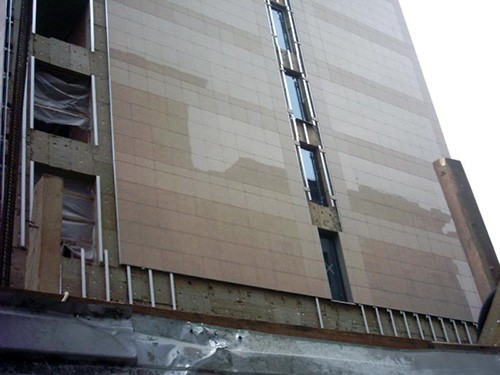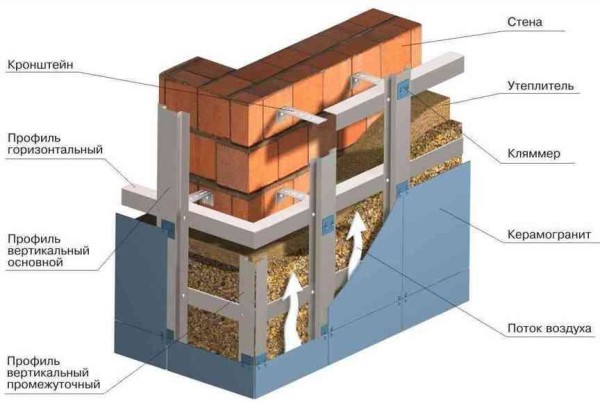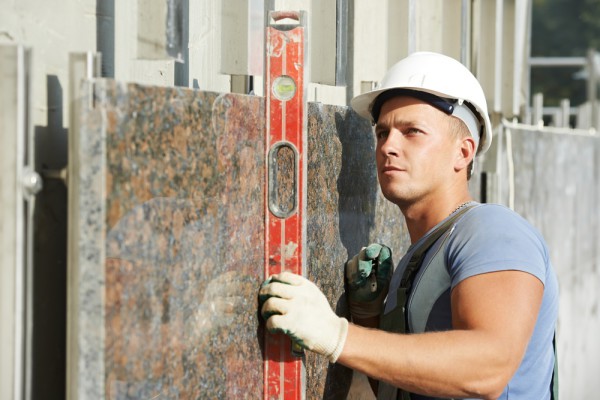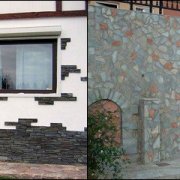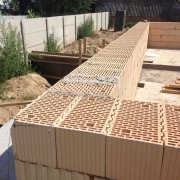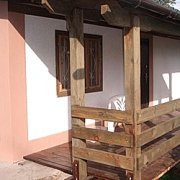Facing the house with porcelain tiles and its features
Today, porcelain stoneware is used successfully. The production technology of this material allows you to get several versions of structures and colors.
So only the main types of porcelain tiles are represented by 9 variations.
The content of the article
Porcelain cladding, characteristics
So porcelain stoneware for building cladding, resembling natural granite, has a high resistance to wear, so this material is quite successfully used not only in decoration and construction country houses, but also in those places where a large number of people are constantly located.
So:
- If clay, rich in illite and kaolinite, is compressed at high pressure, and then burned at a temperature of more than a thousand degrees. It turns out a completely unique material, which in its properties is not inferior to natural granite.
- This material is called porcelain tile. It is produced and used as a finishing material for interior cladding and facade work.
- Its decorative views are glazed with ceramics. The use of such material makes sense, in connection with the optimal ratio of quality and cost.
- But if the financial side allows, matte, polished or satin types of cladding can also be used. Their price is slightly higher, although porcelain stoneware copes well with imitating a variety of materials, as well as more expensive finishing materials.
So, you can purchase porcelain tile that simulates:
- Skin.
- Natural wood.
- Natural stones.
More details:
- Amazing strength characteristics of a material that can withstand loads of up to several hundred pounds per 1 square. inch, provides a long service life of the facade coating.
- Exterior wall cladding with porcelain stoneware is made of separate tiles, which can have a rectangular or square shape. The smallest tiles are 15 cm long.
But these dimensions in the facades are used very rarely. Most often, if they are used, then to dilute and decorate a single motive.
For reference. Facing houses with granite is carried out by larger materials. Such panels can reach a length of more than 3.5 m and more than 1 m in height.
To install the plates, a special metal frame or glue is used.
This mounting feature is associated with the physical properties of the material:
- Due to the very high frost resistance, porcelain stoneware does not always remain on the base made of cement compositions. By the way, natural granite or some other stone undergoes much more severe deformation during frosts.
- Porcelain tile has a solid color and the structure of its entire surface is very strong and durable. This is achieved due to the high resistance of active chemicals.
- The impact load of this class of materials is much higher than that of granite. Throughout the thickness of the material there are no microcracks, which is exactly what porcelain tiles look like precious stones.
Facing buildings with granite, features
When using a material such as porcelain stoneware for wall cladding, this process is carried out according to the same rules and principles as conventional laying ceramic tiles.
For reference. The choice of material can be made in accordance with the figure, with the dimensions of the plates, with the need for shaping and trimming.
As a basis for bonding plates to each other and for attaching them to a wall, the following can be used:
- Glue for plates.
- Mixtures of cement and sand with glue.
When choosing them, it is necessary to be guided by:
- Weighted tiles.
- Surface features of the base material.
- The climatic conditions of the village where the house is located.
In the process of facing buildings with porcelain stoneware, the same tools are used as do regular tiles:
- Building level.
- Lace up.
- Flat spatula.
- Notched trowel.
- Wooden or rubber mallet.
So:
- Perhaps a distinctive feature of this work may be the need for a special grout, which is selected not only depending on natural conditions to protect the adhesive solution, but also to decorate the masonry.
For reference. You can even choose the color of this grout to your liking or depending on the characteristics of the material.
But if, for example, porcelain stoneware is used with some clear pattern and ornament, then you should attach the plates back to back to each other. You will not need grout here.
The installation instructions for porcelain tiles require attention and emphasis on the quality of insulation, and on the presence of air gaps.
DIY porcelain tile installation:
- This process is not very complicated, so you can deal with it almost immediately, just by reading the photo instructions or a training video.
- Ventilated facade made of granite is a structure adjacent to the outer wall of the building. In fact, this is a solid shield of tiles installed at a certain distance from the wall, covering the insulating material.
- Airflows circulating in the gap between the insulator and the screen, which creates porcelain stoneware for facing the external walls, can remove excess moisture that accumulates on the walls and forms in the form of condensate.
- At the same time, a healthy climate is created inside the building with an optimal humidity regime, and the hay itself is protected from rotting in the summer and freezing in the winter.
- Resistance to chemical compounds allows the use of granite in an environment with a high content of aggressive substances. It is made from natural components, therefore it is environmentally friendly and does not emit harmful substances even at high temperature.
From the foregoing, it follows that porcelain stoneware is excellent for facing the facade.
The sequence of works on porcelain stoneware facades of buildings
The preliminary foundation on the walls must be properly checked and cleaned.
Depending on its condition, it will either be possible to start laying the slabs, or it will be necessary to bring the base into proper form:
- So, for example, if the house is built of brick or concrete slabs, then you only need to clean the walls from possible pollution, from dust. The same applies to the porcelain tiles themselves.
- If the house was plastered for a long time, then, for sure, it needs some kind of reconstruction. In case of scattering, cracking and other "emergency situations", it is recommended to remove these plaster areas, apply it again and prime the treated surface and plaster it again.
- Wooden houses require the application of a special reinforcing frame. For this, a reinforcing mesh or an ordinary metal wire is quite often used.
After all this has been applied, it is necessary to fill the grid with cement mortar, which will give the wall rigidity and reliability.
The remaining work is carried out equally regardless of the material and which the house is built. Here you can initially make drawings, according to which tiles will be laid on the facade of the building.
But usually the masonry starts from above so as not to spend too much time and effort on calculating the distance that remains from below.
For reference.
In conclusion, how much space remains, so much and will need to be sawed off from the tiles so that they fit on the wall. The solution is kneaded either only from glue (if the plates are light), or cement and sand will need to be added to it in a ratio of 1: 2.
So:
- First, the solution is applied to the wall with a conventional spatula, then it needs to be leveled with a notched trowel.
- In the same way, each plate needs to be coated with a solution. After that, it is necessary to very firmly press the plate against the wall, rotating it a little so that it drowns in glue. Where necessary, you can tap the tile with a hammer.
- As soon as the entire wall is finished, you need to wash it so that glue does not remain on the tile. In the event that you made spaces between the tiles, you need to fill them with grout.
This is done with a rubber spatula that will not damage the surface of the porcelain tiles.
